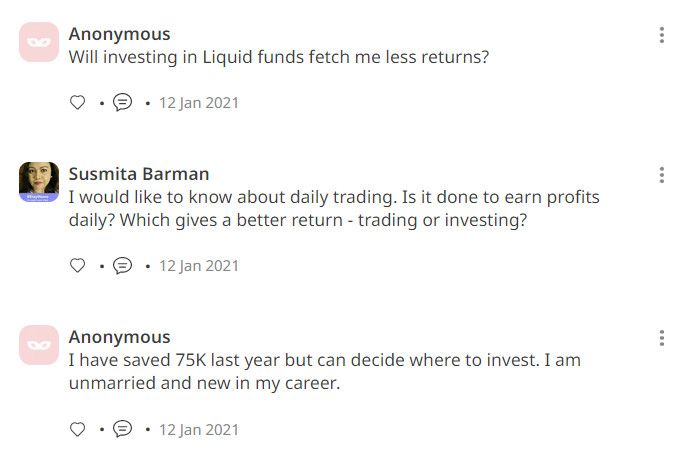Financial Planning Part 2: Investment Planning Options To Build Wealth
Investment planning is the part of financial planning that involves using your investments to meet your financial goals and objectives.
In Part 1, we shared expert financial advice and tips to save money from the best personal finance management advisors. In Part 2 of our series, we share the best financial planning advice from experts on ways to save money for future using the best investment planning options to build wealth.
Learn the best way to save money for future with these tips on investment planning for women. Get the best financial planning advice on the best investment options to help you meet your financial goals.
1. Investing in NPS Vs PPF
Public Provident Fund (PPF) and National Pension Scheme (NPS) are good options for retirement planning.
For the best pension option, you can choose NPS auto-choice option and choose either aggressive or moderate option. At the age of 60, 40% needs to be put into pension fund and you will get pension. Watch the video here for more information.
Public Provident Fund (PPF) gives guaranteed returns whereas National Pension Scheme (NPS) is a market linked product and gives returns based on the allocation to asset classes chosen.
As NPS does not give fixed or guaranteed returns you don’t know the amount you would have at retirement. You can make partial withdrawals from the NPS corpus for specified purposes like children's higher education, child’s marriage, for treatment of certain illness etc.
However, you can exit from NPS only after completion of 10 years. In case of premature exit of a subscriber from NPS, the lump sum withdrawal (20%) is taxable as per the applicable slab rate in the year of withdrawal.
The remaining 80% of the corpus has to be mandatorily converted into annuities and is taxable as per the slab rate of the annuitant in the year of pay out.
PPF gives a lump-sum amount at end of the term, whereas in NPS, you get a certain amount as a lump-sum and the rest in invested into an annuity scheme and you get regular pension.
For PPF investment at 60,000 per year, the amount at the end of 30 years would be ₹16 lakhs, 27 thousand, assuming 7.1% returns.
However, the returns on PPF also change every quarter and hence you can't predict the exact amount. Also PPF has a lock-in period of 15 years whereas NPS is locked in till the age of 60.
2. Investing in post office savings schemes
In the post office, there are savings accounts and time deposits. The PO time deposits are similar to fixed deposits. The only difference is PO time deposits are backed by Govt guarantee and interest rates also are a little higher than FD's.
But monthly, quarterly, half yearly interest payouts are not possible in PO time deposits. Hence, these schemes would not suit those who are looking for regular income.
3. Investing in fixed deposits
In her session on How to be a smart money manager, Dipika gave the following advice on investing in Fixed Deposits.
All FDs are fetching poor interest rates these days. Depositors across the board are feeling the pinch as banks trim their savings deposit rates.
But the bigger issue is that once banks cut rates on savings deposits, they may not hike them again, going by past trends. Hence, you may be stuck with these lower rates for a long while.
In case you were going to consider investing in an FD for 3 or 5 years it may be wise to consider a combination of mutual funds. A simple way of doing this is defining how long you want to invest for and what is your risk-taking capacity.

4. Investing in mutual funds
With little or no experience in the financial markets, it is advisable to start with mutual funds as not only the risk is comparatively less, but also because an expert makes the decisions.
Understand what mutual funds are, types of mutual funds, regular plans, direct plans, etc. Then you can either approach your investment banker or any investment advisor (if you have any already) if you want to go for regular option.
When the markets are low, the Net Asset value of the funds will be lower and you’ll be allotted more units for your investment amount. When markets are high, NAV's would be higher.
Whenever you have 7+ years to go for your goal, invest in an equity mutual fund. When you’re closer to your goal - like 3 years away - move the amount into a debt mutual fund.
You can invest in mutual funds anytime. The earlier you start the better. You can either make a lump-sum investment into mutual funds or make systematic regular investments. Start by investing small amounts via SIP in mutual funds.
SIP or Systematic Investment Plan is a regular way of investing into mutual funds with smaller amounts at regular time intervals. Every month a fixed amount is debited from your account on a fixed date and is invested into the mutual fund.
Investors in their early 30s can try to have at least 30% of savings into equity mutual funds via a Systematic Investment Plan (SIP).
SIPs are beneficial when you want to plan your goals in a more systematic and organised manner, but you can invest a lump sum in mutual funds as well. There is no ideal amount to invest.
It is completely dependent on how much your goal needs and how much you can save per month. The minimum amount for investing in SIP is ₹500 per month, except for certain liquid mutual fund schemes that allow you to start investing as low as ₹100.
Liquid Mutual funds are the best way to kick off your journey as they give you better returns than a savings bank account or FD. You can begin with ₹1000 per month and slowly invest more. You can start your investment journey with HerAlpha at just ₹100.
Higher returns are usually given by certain high-risk investment products. Equity investments in India or abroad may help you with higher returns. With MF you many have to wait for years to double your money. In MF with low duration and low to moderate risk you will get low returns.
There are 3 types of mutual funds - Debt Funds, Hybrid Funds & Equity Fund. Debt fund are short term funds and are suitable for investors with conservative to moderate risk appetite.
Equity funds are long term funds suitable for investors with moderate to aggressive appetite. Hybrid Funds are combination of Debt & Equity Funds.
A beginner with medium risk appetite can start with a multi-cap mutual fund. You could also go for a balanced fund. Remember to keep a time horizon of 7-10 years. You can also choose an aggressive hybrid/balanced fund.
A blue chip fund or blue chip mutual fund is one which invests in blue-chip stocks or stocks of well-established companies with a good overall performance.
If you have the know-how and can choose mutual funds for yourself, you can always do it yourself, but you'll have to spend time do a lot of research around the right schemes that are suitable for you.
If you are new to mutual fund investments and don’t have the required know-how, it is better to take financial advice for a financial advisor. Later, when you're comfortable with mutual fund investments, you can start investing on your own.
You could look at schemes to invest in the Knowledge Center of the Finsafe website. These are based on research rankings.
You could also look Mint 50 recommended schemes and check the returns of mutual fund schemes on sites like Morningstar to compare your scheme’s performance against the benchmark and understand if the fund performance is good or bad.
Also compare the scheme’s performance against peers in the same category. Most important look for long term consistent performance rather than past 1 or 2 year returns. Use apps of the mutual fund registrar (CAMS or Karvy) to track your portfolio status as they are safe.
You could look at taking international exposure to diversify. Investing via international mutual funds is recommended over direct international stocks. Based on your risk profile, restrict international exposure to less than 10-15% of your portfolio.
To start investing in mutual funds, you need to complete the Know Your Customer (KYC) process to verify and authenticate who you are. This is different from the KYC needed for your payment apps. Here are the steps to follow:
- Submit a KYC form with your details
- Submit an ID proof - PAN card
- Submit a valid address proof
5. Investing in stocks Vs trading
If you have the required know-how then you could look at investing in stocks. However, our experts do not recommend investing in direct stocks.
Dipika says: In the current eco slowdown I think investing in shares might be a bit risky, says. The challenge with shares is that you need to do a lot of research. You need to read the balance sheets, projected profits, sales numbers etc and you may not be an expert at it.
Hence, I would strongly suggest that you invest in stocks through mutual funds. They are managed by fund managers who are professionals in that space and know their job well.
Mrin agrees: If you want to invest you can do it through equity mutual funds where the fund manager chooses when to buy and sell and how to manage the fund. All you need to do is decide what amount and what your risk profile is.
Daily trading is ideally done with the intention of booking profits. But it is highly risky and you could also end up losing a lot of money. Investing is definitely preferable over trading. Investing is for long term and trading is to take profits in intervals.
For instance, if you are purchasing goods for yourself it is like Investing and if you buy and sell and take a profit in between, it is trading. It totally depends on your risk, nature, holding and style.
There is no good time to enter the market, just stay long term to get good returns. Like Warren Buffet himself said, “Time spent in the market is more important than timing the market.”
What are Nifty funds?
There are various Nifty 50 funds. Nifty funds are Index mutual funds which mirror the Index which is Nifty 50. Index funds imitate the portfolio of an index. Nifty funds would have investments in stocks which are same as the stocks comprising Nifty.
You can invest in Nifty funds for diversification in your portfolio. So if Nifty stocks perform well, your fund would perform well too. It is a passive fund. This video explains more about active and passive fund portfolios.
You can choose schemes based on consistent track record from Morningstar.in, Mint 50 recommended schemes or the Finsafe website.

6. Buying gold as an investment
Digital gold is new Gold investment where you can invest as little as ₹1 through your Wallet. When you redeem you have two options either to take physical gold (as per prescribed limit) or money. The time to hold is different with different wallets varying from 5-7 years.
Wallets are just the Medium/Broker through which you are investing Gold from two major companies - MMTC and Safegold. The former is Government and later is a private player.
As a whole, it is not recommended to have more than 5-10% of your entire investment portfolio in Gold. If it is for personal use, then you can choose gold jewellery.
Gold Exchange Traded Funds (ETF) and Sovereign Gold Bonds (SGB) are definitely a better option over physical gold as an investment. SGB is less risky than equity mutual funds. But the lower the risk the lower will be the returns as well.
You can look at investing in Gold via SGB when the next tranche of SGB comes up for subscription. Watch this video to learn more about SGBs.
Investing during Diwali & Dhanteras
“You can never be prepared enough for the festive season and no one wants to live with the worry of expenses going up or paying off credit card bills,” says Dipika.
A simple example: If you think you’ll need ₹60,000 next year at the same time for festival expenses, you can start saving around ₹4 to ₹5k a month now in a low-risk mutual fund.
The investment in this can be done through a systematic investment plan, where on a fixed date a fixed amount is debited from your bank and goes into the fund. So, you have set up a smart system to tackle next year’s expenses starting now.
On Dhanteras, you could look at Gold Exchange Traded Fund (Gold ETF) for investing into the gold asset class. This is a better way of buying gold rather than buying physical gold and can be bought with much lower amount.
“Do not look at just saving, try to invest also,” says Mrin. “You can look to put it in part of your amount into a PPF account and with the rest you could start an SIP into a mutual fund.”
7. Investing in real estate
Property for personal use is fine. But real estate as an investment may not be a great option as the rental yields are not great and it’s not recommended because of various other reasons like liquidity in real estate. Returns in real estate are not more than 5 to 6% generally.
Teachers & educators, apply for a Mahila Money loan
Are you an online tutor, educator-entrepreneur, or school teacher? Mahila Money is celebrating the women teachers who have changed our lives for the better.
So, all through the month of September, you can avail an interest-free loan of INR 10,000 to 25,000. Click here to apply for a Mahila Money loan today.
Also read:
- Financial Planning Part 1: Expert Tips To Save Money
- Financial Planning Part 3: Buying The Right Insurance Coverage For Financial Protection
- Financial Planning Part 4: How To Manage Debt And Use Credit Cards Wisely
- 5 Smart Steps To Financial Independence For Women
















